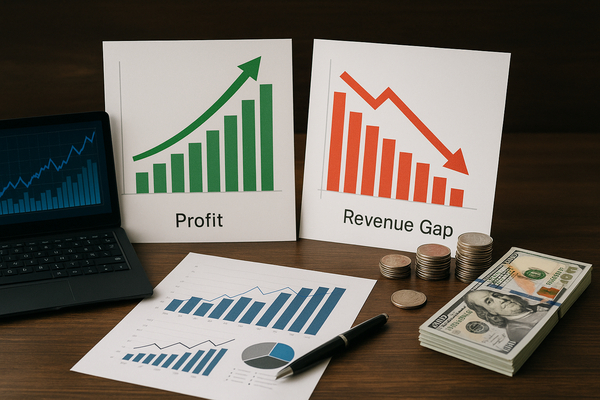
As the third-quarter reporting window unfolds, a pattern is emerging across financial firms: headline revenues are telling one story while adjusted profits and capital moves are telling another. The data set from the latest batch of releases and analyst notes shows strong fee and origination momentum in some corners of the market, one‑time items and balance‑sheet management masking top‑line weakness for others, and sustained private capital deployment that is reshaping real‑asset and credit markets.
Profit beats with headline misses — the accounting and origination story
Several companies reported third‑quarter results that highlight the divergence between GAAP revenues and non‑GAAP earnings. Arbor Realty Trust (NYSE: ABR) posted sales of $112.4 million in Q3 CY2025, a steep 28.2% decline year‑over‑year, yet reported a non‑GAAP profit of $0.35 per share that was 48.9% above analysts’ consensus. Those figures summarize a recurring theme: legacy asset resolutions, runoff in certain originations and portfolio reshaping can depress top‑line numbers while improved spreads, cost controls or accounting adjustments boost reported adjusted EPS.
The private capital and credit side shows the opposite: origination engines are firing and lifting revenues. Ares Management reported approximately $15.2 billion in U.S. direct lending new commitments in Q3 and roughly $49.3 billion closed over the 12 months ended September 30, 2025 — evidence that private credit remains a preferred channel for both borrowers and yield‑seeking institutional investors. OneMain Holdings (NYSE: OMF), a consumer financier, beat revenue expectations with $1.27 billion in sales (up 9.8% year‑over‑year) and a non‑GAAP profit of $1.90 per share that came in 18.5% above consensus, underscoring strength in consumer credit demand and origination economics.
Asset managers are likewise splitting the difference. Affiliated Managers Group (NYSE: AMG) reported $528 million in Q3 sales, up 2.2% year‑over‑year, and net income of $212.4 million. Economic earnings per share of $6.10 reflected both operating gains and a sizeable transaction benefit: roughly $100 million of the net income included a gain on the Peppertree transaction. That one‑time gain helped drive a positive investor reaction — shares jumped about 6.2% in the session following the release — but analysts are parsing recurring fee flows, net client cash trends and the sustainability of those gains.
Other managers such as T. Rowe Price and WisdomTree reported steady fee momentum. T. Rowe Price posted revenue of $1.89 billion, up 6% year‑over‑year, and non‑GAAP EPS of $2.81 — 10.5% above consensus — while WisdomTree announced $125.6 million in sales, an 11% increase year‑over‑year, with non‑GAAP EPS of $0.23, 10.4% ahead of estimates. Carlyle Group (NASDAQ: CG) provides a counterpoint: Q3 revenue fell 12.6% year‑over‑year to $782.5 million and its non‑GAAP EPS of $0.87 missed estimates by about 15%, illustrating how private equity realizations and fundraising cadence can drive quarter‑to‑quarter volatility.
Capital deployment: infrastructure, offshore wind and targeted acquisitions
One of the clearest cross‑market trends is continued capital allocation into infrastructure, energy transition projects and platform acquisitions. Apollo‑managed funds committed $6.5 billion for a 50% stake in Ørsted’s Hornsea 3 offshore wind project in the U.K., a transaction that signals appetite for long‑duration, contracted cash flows despite higher rate backdrops. At the smaller end of the spectrum, LTC Properties announced a $23 million SHOP acquisition in Georgia, illustrating how REITs continue to add accretive operating portfolios to diversify revenue sources and boost yield.
Private markets and credit platforms are marshalling capital to meet demand. Apollo’s activity in data centers — completing its majority acquisition of Stream Data Centers — shows where institutional capital sees structural secular growth: hyperscale supply constraints and corporate cloud demand. Those same capital flows underpin Ares’ robust direct‑lending numbers and are visible in the sizable deal pipeline for specialized credit products.
At the same time, bank and regional finance results are reflecting a mix of stronger net interest income and pressure on credit metrics. OFG Bancorp reported net interest income of $154.72 million and net income of $51.84 million in Q3, while net charge‑offs rose to $20.2 million; management also completed a tranche of share repurchases and declared a $0.30 per share quarterly dividend payable January 15, 2026 (record date December 31, 2025). Those figures demonstrate active capital allocation even as loss rates tick higher.
Where to watch next: data points that will matter
Investors have several clear items to monitor as the reporting season progresses. First, the sustainability of fee growth and client flows at asset managers: net client cash inflows are a critical read for firms that trade on recurring fees. Affiliated Managers reported roughly $9 billion of net client inflows in the third quarter and about $17 billion year‑to‑date, but the market will look to see whether those levels persist once one‑time transaction gains are stripped out.
Second, origination and credit performance across consumer and private credit lenders. OneMain’s top‑line strength and Ares’ underwriting cadence are positive indicators, but rising charge‑offs at regional banks and specialty lenders will be watched closely for signs of stress. Upstart has seen its Fair Value Estimate nudged from $75.46 to $74.69 and its share price has pulled back materially over recent months — a reminder that high‑growth fintech valuations remain sensitive to loan performance and underwriting shifts.
Finally, energy and infrastructure allocations will remain an active theme. Large commitments like Apollo’s $6.5 billion Hornsea 3 investment and ongoing platform buys for data centers and operating portfolios underscore that long‑duration assets are attracting patient capital even as markets weigh rate and macro risks.
The reporting period offers a rich set of data: revenue beats and misses, outsized non‑GAAP EPS effects from one‑off items, and continued private capital deployment into targeted assets. For market participants, the task is to separate transitory accounting and transaction effects from durable operating improvements. The companies that can show repeatable fee streams, resilient origination economics and disciplined capital allocation will likely command higher multiples — while those dependent on legacy asset resolutions or lumpy realization events will remain more difficult to value.
Keep an eye on upcoming earnings and event calendars — several fintech and payments names are due to report in early November, and central bank commentary plus geopolitical headlines can still influence risk sentiment. The next handful of quarters will test which of these trends are cyclical and which are structural.












